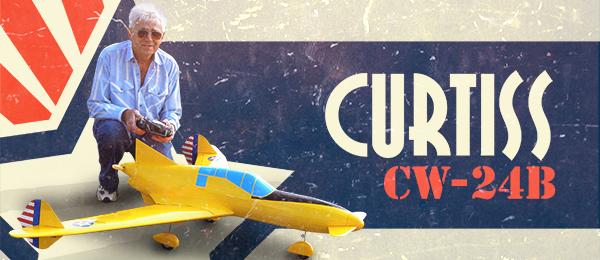Written by Ernie Heyworth.
A Golden Age classic turns out to be a natural for electric power.
Featured in the Model Aviation October 2006.This airplane was developed during 1929 and the early 1930s, during the Great Depression; luxury airplanes weren’t selling then. At the Buffalo, New York, plant design center, Glenn Curtiss and Walter Beech (of the later Beech Aircraft Corporation) decided to build a light, inexpensive airplane. It was to be constructed at the Saint Louis, Missouri, plant, which needed work or faced shutdown. Curtiss and Beech wanted an airplane that would weigh less than 1,000 pounds and hoped to sell it for roughly $1,500. Today’s ultralights weigh approximately 300 pounds and have 50-horsepower engines. They cruise at 70 mph and cost roughly $8,000. The ultralights and the Junior are almost the same size. The CW-1’s design came from the English Buzzard and the wood Curtiss-Robertson Skeeter. Glenn never outgrew his love for the pusher-type aircraft. His first designs were pushers that were similar to the Wright brothers’ Wright Flyer. Glenn’s June Bug and other aircraft he developed were advancements beyond the Wright Flyer. His team made design changes to the early June Bug such as adding wheels, pontoons, ailerons, bigger engines, and better controls. He established the aeronautical leading edge of the time. The Wrights and Curtiss locked each other up in court battles over the invention of all airplanes and all motor flying machines. This patent fight set the US back in the design progress of airplanes at the outbreak of World War I. The Europeans took the leading-edge development. They added tractor engines, better wing structures, and much greater performance to the basic airplane. The US government finally paid off Glenn and Orville to settle their dispute so that the Americans could catch up with the Europeans. Curtiss and the Wrights then collaborated to make radial engines and some of the greatest airplanes of World War II. The CW-1 Junior was a bit of a joke among the pilots of the day. It looked a little like the Aeronca C-3 “Flying Bathtub” or a cross between a seaplane and a sailplane, but it sold well during hard times. The Junior was easy to fly, it had a low stall speed, it could land in small farm fields, it had a metal frame, and it had good visibility for photo surveying. Air-show pilots loved this airplane; the large wing let them park it into the wind. The CW-1 was a money-maker for giving rides, although a few passengers walked into the pusher propeller. The barnstormers used it to do the flying farmer routine. Most of them put more powerful engines on them. The Szekely wasn’t dependable; it threw oil and often blew a jug into the pusher propeller. The Curtiss-Wright Junior certainly has left its mark on aviation history, and it is worth modeling.

There's no chance of a propeller strike on takeoff! It's simple in design and form, but has an understated elegance.

In flight, the CW-1 has a buoyant appearance. Its is lightly loaded and properly powered. This is a great fun-scale flier!
Order Plans from AMA Plans Service











Comments
more info
It would be nice if this article included the size (scale) of this plane.
dimensions of aircraft
Anyone know wing span and lenth of aircraft?
Curtis-Wright CW-1
After doing a little research and finding the build article, the wingspan is 53". The build article is at : http://library.modelaviation.com/ma/2006/10/curtiss-wright-cw-i-junior-… I hope that someone at AMA figures out that these plans articles need more specs.
CW-1
Specs are a must. It's the first thing I look for to decide whether to buy it or not.
Plane airplane model
Hi.
I want to make this model aircraft. So I need a map. Send the map file to cdr or dxf format.
Add new comment